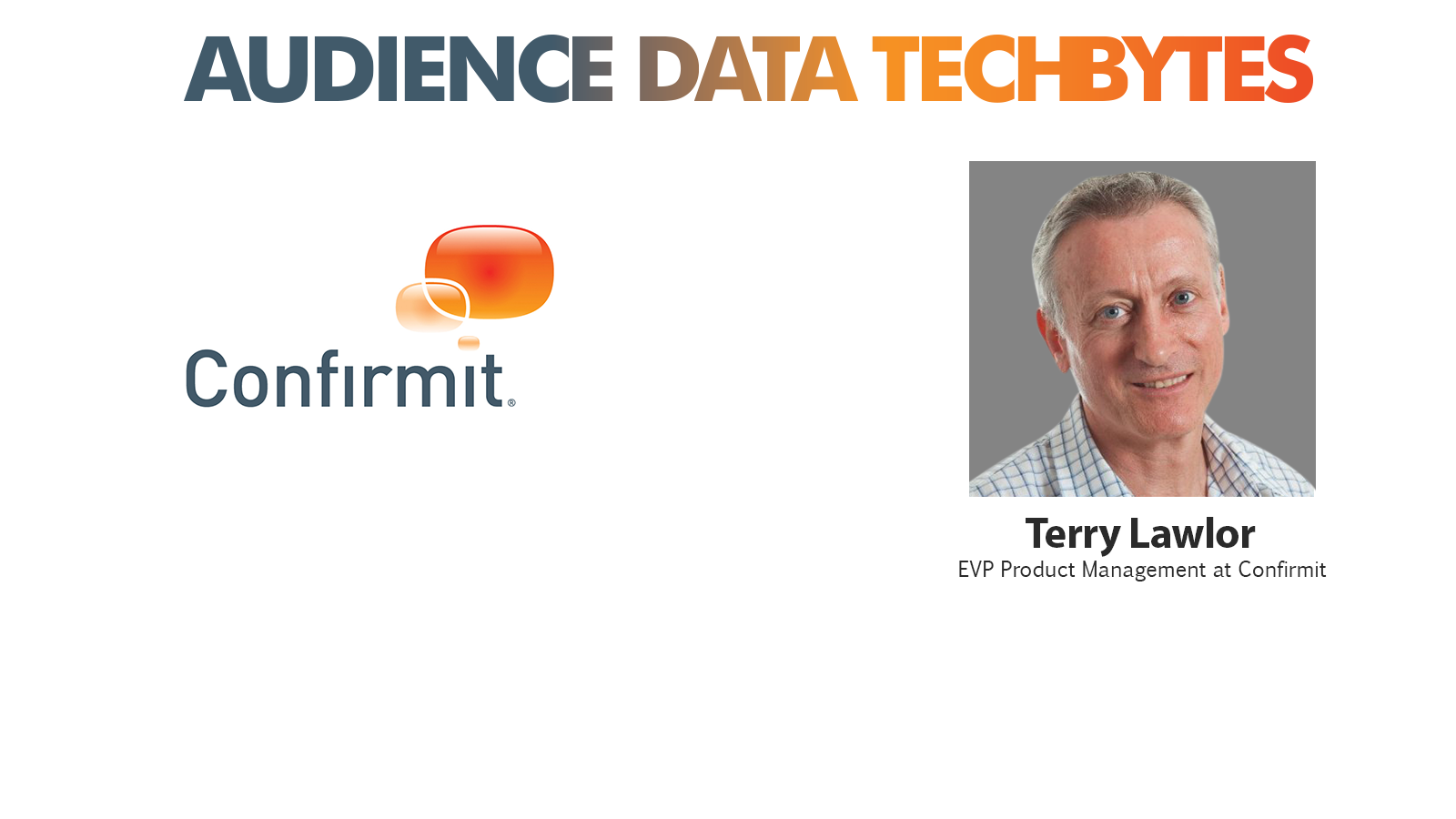
Recently named as the leader in the Forrester Wave: Customer Feedback Management Platforms Q2 2017, Confirmit helps clients improve their business performance with Action Management, Text Analytics, Data Integration and Social Media. To understand the changing dynamic of data analytics for audience reach, we spoke to Terry Lawlor, EVP Product Management at Confirmit.
MTS: What is your role at Confirmit and how did you get there.
I’ve been EVP of Product Management at Confirmit for just over four years, having started at the company in April 2013. In my role, I oversee all aspects of product management, including strategy development, product definition, and product representation in client and marketing activities. What I enjoy most about working at Confirmit is that I’m able to blend my knowledge of enterprise software with my love of helping businesses better understand their markets and customers, and utilize that knowledge to drive meaningful business change.
Since the onset of my career, I have always had a passion for technology. I have more than 30 years of experience in leadership positions at high-growth software companies, helping many global enterprises solve complex business issues with innovative software solutions. Prior to joining Confirmit, I oversaw Marketing and Business Development at mobile app specialist The App Garden, and before that held senior executive roles in product management, marketing, sales, and operations at global customer experience leader, SDL.
MTS: How do Audience Data and Customer Data differ? How does Confirmit help marketers attribute Voice of Customer to the right source?
Customer data and audience data are similar in a sense, but what you are able to do with the data is what distinguishes them. Customer data is a specific set of information pulled from a targeted group of customers. It is often gathered through a single solution, such as a CRM or customer experience platform. Audience data is a broader and more outward-facing collection of information and can be made up of various data sets. This information is defined, collected, and owned by the company itself (first party), a partner (second party) or a vendor (third party). Audience data is helpful for advertising campaigns and event planning, whereas customer data is helpful for businesses internal practices and customer experience management.
Confirmit’s technology and services support both sets of data. Many of the leading market research agencies collect audience and market data using our platform. Our customer engagement model, Confirmit Voices, allows business to listen to their customer base and integrate it with audience data to generate powerful insight, and take action that delivers real business change. Confirmit Voices uses multi-channel data collection that gives you the power to listen to the customer at each key touchpoint and adds that to the separate stream of financial and operational data, as well as rich media such as photos and video.
MTS: How should marketers leverage social media marketing platforms to refine their B2B processes?
There’s no denying the value that social media has in measuring customer sentiments. At their core, Twitter, YouTube, and Facebook are digital diaries of thoughts and experiences recorded over time. In a B2B context, sites such as LinkedIn come into play, as well as numerous online resources such as blogs and news media. It is imperative that businesses “listen” to these socially shared opinions to better understand market trends and how their customers genuinely feel about their brand. This can give marketers the language that their customers use, which they can then use to match their product offerings and marketing campaigns to their customers’ needs and wants.
However, social listening can only be a rich source of insight if the data can be handled effectively. There are now analysis tools that can identify key social performance indicators (likes, follows, etc.), market sentiment, and a client’s competitive positioning automatically, allowing marketers to analyze unsolicited feedback without having to manually monitor review sites, forums, discussion boards, and blogs. With approximately two billion people active on social media accounts daily, it’s clear that this is an area of technology that marketers should invest in.
Recommended Read: Confirmit Compass Guides Companies Along the Path of VoC Maturity
MTS: What do you see as the key challenges that brands face in leveraging Customer Feedback Management to deliver customer experience?
A key challenge is gaining the necessary leadership support essential to CX sustainability. CX has the power to transform businesses but needs backing to secure both budget and company-wide participation. While most organizations accept that a commitment to the customer experience is a good idea, CX professionals need to provide hard facts and data to ensure support from the top. This means demonstrating ROI, delivering a clear, phased roll-out of a program, and delivering some quick wins in the early phases. An executive sponsor goes a long way towards securing credibility for a CX program, so it’s vital to talk figures, not fluff.
A second challenge is the sheer volume of data that companies need to deal with. Before you even begin to capture customer feedback, there is CRM information, contact center records, emails, and the tsunami that is social media. Once you add direct feedback from multiple touchpoints (website, post-purchase, renewal, etc.) it can be utterly overwhelming. However, this isn’t something companies can avoid dealing with because silos of this data not only prevent you from uncovering insights that will drive future success, but they are often glaringly obvious to customers who end up with a horribly disjointed experience. Ensuring you have the right technology in place to pull together data from different sources so you can make sense of it is a critical first step in untangling this web of information.
Lastly, we have the issue of simply not managing or sustaining the customer feedback program. Many companies install some software, adjust some procedures, add a few pages to their websites, and then go back to business as usual. Just checking these items off the list won’t make a big difference and B2B customers can tell when a company treats them in a ‘set and forget’ kind of fashion. There is no point pushing surveys at customers if you do not heed what they say, when they say it. It’s vital to get insight out into the business in real or near real-time. To do so, use concise, tailored, live reports that put the insights stakeholders need at their fingertips, give them the tools to take action based on those insights, and then provide the ongoing feedback that shows the impact of their actions.
MTS: How deep is Confirmit into Artificial Intelligence and Machine Learning (AI/ML)? How can AI capabilities help marketers listen to their customers better?
Artificial intelligence can be a valuable tool in connecting with customers. For businesses conducting a CX effort, the technology can help them sort through volumes of customer data more efficiently and develop their products and services based on patterns of customer behavior and preferences found in the data. However, it’s important not to jump on the AI bandwagon without a plan. The zeal to embrace this new technology can lead businesses to forget about the actual end goal – improving customer experiences. CX pros must help their businesses think through how best to build and deploy an intelligent experience so better results can be achieved. For the customers, AI can provide them with immediate, human-life assistance based on their unique context and needs.
Our solutions already make use of advanced analytics (predictive and machine learning). We leverage deep learning techniques for our social and text analytics software, Confirmit Genius. The exponential rise in unstructured text data is a signal that it can no longer be ignored if companies want to stay competitive and it is something our customers are increasingly looking to leverage in their VoC programs. Confirmit Genius provides categorization and sentiment analysis for free-form text and automatically determines sentiment by category for each piece of content that needs to be analyzed. We continue to research how AI capabilities can advance the metrics our customers can measure from the data they collect, giving them a deeper look into market and customer trends over time.
MTS: How should brands leverage Voice of Employee (VoE) to improve their own customer targeting and sales retention? Does Voice of Employee have a direct impact on the Voice of Customer?
Organizations can make better business decisions if they align insights from all stakeholders, including customers, employees, and also third parties such as partners and suppliers. VoC provides insights that fuel improvements to the customer experience and VoE does much the same for employee engagement. Employees also have incredible insights into the customer experience and organizations can tap into this knowledge via VoCE – Voice of the Customer through Employee. VoCE can drive deeper customer insights as well as improved employee engagement. VoCE is a concentrated effort to look at both sides of the coin. Instead of just focusing on ways to grow the sales pipeline, businesses must first look internally and identify their core values. Once these are determined, companies should assess how these values could affect – and be represented by – employees, and how those values will filter to the customer level. The way employees think, act, and treat customers reflects the company ethos as a whole and affects the way customers perceive the brand and the people behind it.
Organizations need a combination of methodology and technology to align VoC with VoE. Techniques include empowering local management to rapidly sense check customer and employee experience using ad-hoc pulse surveys and allowing data collected through employee surveys to be combined with data from customer surveys. Advanced analytical tools can correlate employee engagement with customer loyalty, and identify key drivers for business improvement, thereby helping to identify which parts of the business hold the key to growth.
Studies show that engaged employees have a much better understanding of customer needs than unengaged employees. This means that they provide better customer experience and drive greater profitability. It follows, then, that assessing and boosting the engagement of your staff, and making it part of your Voice of the Customer program, is likely to have a direct impact on your relationship with customers and the experiences they receive through your organization.
MTS: Thanks for chatting with us Terry.
Stay tuned for more on business insights on marketing automation, content marketing, video ad tech, programmatic and header-bidding technologies. To participate in our Tech Bytes program, email us at news@martechseries-67ee47.ingress-bonde.easywp.com











